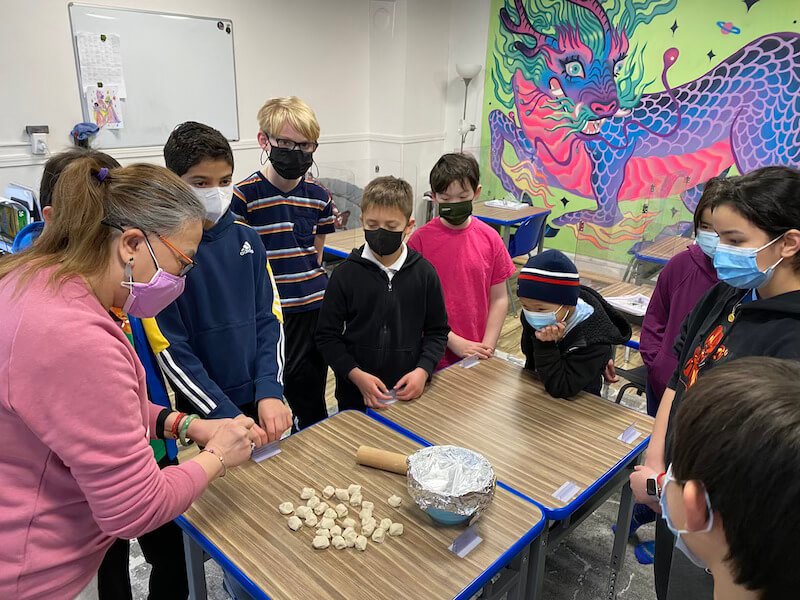Science and Technology Curriculum
WSA’s Science & Technology Curriculum is informed by the Next Generation Science Standards (NGSS).
Grade 4
Objectives:
Students will acquire foundational knowledge of the composition of the solar system; Earth’s geology; states of matter; and the cellular bases for life on Earth. Students will also understand, through theory and practice, how to collect, compile, and analyze data.
Texts:
Marshall Cavendish Lower Secondary Science Matters, Teacher created lectures and slides
Content:
Earth & the Solar System
- Make-up of the solar system: Sun, planets, moons
- Earth as the “Goldilocks Planet”: conducive to life (not too hot, not too cold!)
- Lab: Creating a Solar System
Earth’s Geological Systems
- Earth’s composition and atmosphere
- Plate tectonics and large-scale system interactions
- Geological ages and the movements of the continents over time
Earth’s Systems of Life
Life’s building-blocks: from molecules to organisms
- Models of cells
- Plant and animal cells: structures and functions; similarities and differences
- Life cycles of cells
- The microbial world: viruses and bacteria (functions and replication)
- Lab: Create an animal/plant cell
- Lab: Microbial Swab: The Invisible World Around Us
Ecology
- Vertebrates and invertebrates
- Classification of animals
- Water and nitrogen cycles
- Lab: Building a Self-Sustaining Terrarium
Matter and Its Interactions
- Properties of matter
- States of matter
- Chemical reactions
- Lab: Volcano
Grade 5
Objectives
Students will acquire foundational knowledge of the Scientific Method, systems of life on Earth, and human anatomy. Students will also understand, through theory and practice, how to collect, compile, and analyze data.
Texts
Lower Secondary Science Matters
Marshall Cavendish Education
Content
The Nature of Science
- The Scientific Method
- Models of cells
- Structures and functions of plant and animal cells; similarities and differences
- The microbial world
- Viruses and bacteria (functions and replication)
- Lab: Swabbing for Microbes in Yogurt and on the Human Cheek
Life on Earth
- Component of the Earth’s systems
- Plate tectonics
- Effects of human activities
- Ecology
- Vertebrates and invertebrates
- Classification of animals
- Classification of plants
- Water, phosphorous, and nitrogen cycles
- Lab: Self-Sustaining Terrarium
Human Anatomy
- Basic human anatomy
- Systems: cardiovascular, respiratory, and muscular
- Lab: Biomedical Engineer: Make a Digestive System
Grade 6
Objectives
Students will understand and apply the Scientific Method using standards of measurement; learn to design, conduct, and write reports of laboratory experiments; recognize the diverse compositions and properties of organic and inorganic matter; understand the classifications of atoms on the Periodic Table; review and deepen understanding of aspects of human anatomy.
Text(s)
Lower Secondary Science Matters
Marshall Cavendish Education
Content
The Nature of Science
- The Scientific Method
- Standards of measurement (metric system)
- Introduction to lab procedures and reports
Models
- Structure and function of plant and animal cells; similarities and differences
- The microbial world
- Viruses and bacteria (functions and replication)
- Lab: Capturing and Identifying Microbes in the Air, in Antibacterial Agents, and in Soaps
Diversity
- Densities and physical properties of matter
- The diversity of matter as shown by chemical composition
- The diversity of organisms
Motion & Forces
- Understanding and describing motion
- Acceleration
- Force
- Newton’s Laws
- Gravity
- Lab: Tug of War Study of Newton’s Second Law of Motion
Life on Earth
- Components of the Earth’s systems
- Plate tectonics
- The effects of human activity
- Lab: Designing an Earthquake-Resistant Structure
Atoms & the Periodic Table
- The Periodic Table
- Mixtures and compounds
- Metals, nonmetals, and metalloids
- Lab: Gumdrop Atoms
Human Anatomy
- Basic human anatomy
- Systems: cardiovascular, respiratory, and muscular
- Lab: Biomedical Engineer: Make a Grasping Robot Hand
Grade 7
Objectives
Students will understand and apply the Scientific Method using standards of measurement; learn to design and conduct laboratory experiments; write increasingly complex and well-structured laboratory reports; and understand the structures and foundational concepts of energy, force, gravity, electricity, magnetism, sound, chemical changes, and human organs. Students will also acquire a sense of wonder about the world around them as they increasingly recognize the science that governs their everyday lives.
Texts
Lower Secondary Science Matters
Marshall Cavendish Education
Content
The Nature of Science
- The Scientific Method
- Standards of measurement
- The structure of lab reports
- The science of our everyday lives
Motion and Forces: Energy, Work, & Simple Machines
- The nature and conservation of energy
- Work
- Understanding and using simple machines
- Lab: Newton’s Laws as Proven By Catapults
Electricity & Magnetism
- Electricity
- Electrical current and circuits
- Ohm’s Law
- Magnetism
Sound Energy Through Vibrations
- Sound: audible waves
- The music and uses of sound
- Sound and society
- Lab: Circuitry Through Yogurt-Cup Speakers
Chemical Change
- Types of chemical changes
- Bonds
- Solutions, mixtures, and compounds
- Interactions between matter
- Movement of atoms during chemical reactions
- Effects of chemical changes
Human Anatomy
- The human digestive system: organs, enzymes, structure, and function
- The urinary system
- Lab: Just Like Kidneys: Semipermeable Membrane Prototypes
- The nervous system: brain cell communication
- Lab: Observe Symptoms Demonstrated by Mock Patient and Diagnose Affected Organ Systems
Grade 8
Objectives
Students will recognize and understand concepts and processes of evolution; natural selection; genetics (variation and distribution); the relationships between genetic molecules and organisms; the history and energy of our solar system; the geology of Earth; climate change; the impact of human activity on climate and biodiversity; and particle physics.
Text(s)
Physics Matters
Chemistry Matters
Biology Matters
Marshall Cavendish Education
Teacher-generated materials
Content
Natural Selection & Evolution
- Evidence of common ancestry and diversity
- The four factors of Natural Selection
- Adaptation of populations
- Natural Selection and environmental adaptation
- Environmental changes: speciation and extinction
- Lab: Battle of the Beaks-natural selection activity students will simulate Darwin’s finches and see how survival of the fittest can lead to evolution
Genetics
- Cellular division and differentiation
- Chromosomal inheritance
- Inheritable genetic variations
- Variation and distribution of traits
From Molecules to Organisms
- Genes, proteins, and tissues
- Interacting body systems
- Feedback mechanisms and homeostasis
- Lab: Berry Full Of DNA- DNA Extraction
Earth Space Science
- Nuclear fusion and the Sun’s energy
- The Big Bang Theory
- Orbital motions
- Evidence of plate tectonics
- Evidence of the Earth’s history
- The creation of landforms
- Carbon cycling in the Earth’s systems
- Coevolution of life on Earth
- The impacts of human activity on Earth systems
- Biodiversity, natural resources, and human sustainability
- Climate change and future impacts
Physics
- Fission, fusion, and radioactive decay
- The Second Law of Thermodynamics
- Macroscopic energy due to particle position and motion
- Wave-particle duality of electromagnetic radiation



